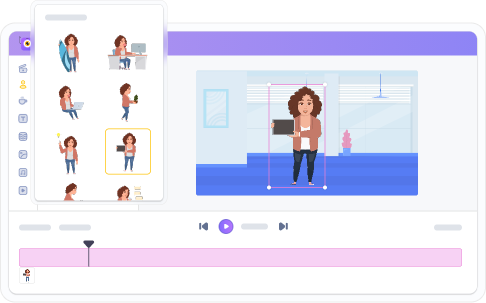6 Tips to develop a microlearning strategy for corporate training
It’s true that microlearning courses are highly effective for training employees in the corporate world.
Breaking down heavy chunks of learning information into smaller pieces helps both - the employees and the L & D team.
Employees don’t have to feel anxious about completing lengthy courses. As employees are in charge of their own learning schedule, the L & D team doesn't have to worry about following up with the employees.
But, creating a microlearning course is one thing, and developing a microlearning strategy is another. It’s like talking about how to fly an airplane, and building an airplane.
We’ve already talked about how to fly an airplane, i.e. how to create a microlearning course. In this blog, we will tell you how to create a microlearning strategy for long-term success.
6 tips to develop a microlearning strategy
1. Collect data
Collecting data for developing a microlearning strategy is like building a formidable base for the course first. Data gives a solid foundation to work on the course structure and build personal learning experiences for the employees.
Data can be collected in the form of surveys or interviews with employees to understand their expectations from a course. What will motivate them to learn and what are the key takeaways that will encourage them to attend the course.
Another excellent idea is peering into employee performance in past tests or quizzes relevant to the topic of the microlearning course. Employees might not be very co-operative during one-to-one chat. Getting all the details can be tough. Additionally, a quiz creator can be used to create a quiz that effectively gathers employees responses.
But, this is gold. There is no chance of tampering with the data. You get real information of how the employees fared. What made them stuck, which chapter was the easiest, and what was their feedback.
All this information can be excellent fodder for your microlearning strategy.
2. Focus on storytelling
A microlearning course can turn boring for employees if the flow is flat. The flow is basically the content of the course - the slides or scenes that come after the other from the start till the end.
This flow can be made a lot more interesting by adding scenarios, animated characters or quizzes that are inspired from real-life situations. These simple interactive elements in a course improve engagement. Besides, it also helps employees to connect with what they’re learning.

Another idea that can be useful in storytelling is asking employees to record content for the course. Especially senior employees who are more experienced. It can be a simple screen recording, statement or a voice note. This type of content makes immense value addition, and more empathetic for employees.
But, to do all of this, a capable authoring tool is much-needed. A tool like Vmaker Author. You can add high quality videos, DIY animations and track the metrics all in one place.
Therefore, while making microlearning courses analyze ample authoring tools and choose the one that goes along with the storytelling.
3. Set up a reward system
Building a reward system gives additional support to the storyline of the course. A reward system is a strategy for acknowledging the efforts of the employees. By rewarding employees you keep them motivated and glued to the course.
The reward can be as simple as confetti balloon animation or a certificate of appreciation. The essential element is to give some sort of boost to the employees as a form of validation.
The rewards can be kept at the end of the course if it’s a short course. Or, it can be kept at different intervals or levels within the course. This second idea is more useful in case of longer courses with multiple chapters.
Keeping milestones within the course for completing an “x” number of challenges is also a popular technique in microlearning training. Milestones also help employees know how far they’re away from earning the next reward.
4. Optimize for mobile learning
Optimizing the microlearning course content for mobile phones shouldn’t be missed at any cost while making a microlearning strategy.
Microlearning courses are best suited for mobile learning. The reasons behind this are very simple -
1) Almost every employee owns a mobile phone. This means the L & D team does not have to go an extra length to educate employees on how to use the device. If the course content is mobile-friendly, they can maneuver on their own effortlessly
2) Employees are well-acquainted with mobile learning already. Almost 50% of the apps that are downloaded by mobile users are for learning. It’s natural that a considerable amount of these users are employees in the corporate sector
3) Giving the option to access the course from a mobile phone is giving more autonomy to employees to decide their timeline. This will be welcomed by employees as they get more freedom to decide their timeline. Also, they don’t have to stick to their work computer
4) Mobile learning produces efficient results. For example, people who learn from their mobile devices tend to complete the courses 45% faster than other devices.
Mobile learning is the future and there are ample research studies to support this. Therefore, making the training content optimized and responsive for mobile devices should be the need of the hour for the L & D teams
5. Stress on the quality
If L & D teams and corporate trainers want high performance from employees after they have completed the microlearning course, then they have to make quality the core part of the strategy.
By doing this, the learning teams can set themselves up on the path of continuous improvement. But, there are two aspects of this quality improvement - Feedback and Experiments
1) FeedbackFeedback from employees is going to be the strongest indicator of the quality. After a course is complete, it should be a mandatory practice to ask employees for their feedback and thoughts.
A simple questionnaire, quick interview or a fireside chat with all the employees is all that is needed. In these interactions, the challenges faced by the employees during the course should take the center stage.
Along with that, their suggestions on overcoming the challenges and improving the overall quality should be emphasized.
2) ExperimentsExperimenting with ideas like using different gamification techniques. Or using a unique rewarding system to incentivize the efforts of employees can be highly effective for enhancing the quality.
Sticking to the same flow can become monotonous after a point. This drops the morale of the employees. Therefore, in spite of the quality being good, employees might flag it as bland.
To encourage more ideas, L & D teams should sit together and brainstorm ideas. This can be done on a monthly or quarterly basis depending on the frequency of the courses.
6. Set guidelines
Lastly, an important part of the microlearning strategy should be about setting guidelines. These guidelines will be like handrails for the team that will guide them while making microlearning courses.
These guidelines should also include a process which clearly defines what type of content should be fit for microlearning. It should also include brand guidelines like font type, color of the slides, image size and video background. This will ensure consistency.
On top of that, if there are multiple teams within the corporate training team, an organization flow is also essential. Which team takes care of what and who approves what should be clearly defined.
Get. Set. Go
Building a microlearning strategy is setting the pillars for the course. Using the above ideas will be very helpful in strengthening those pillars.
Start the strategy by collecting data from the past tests and quizzes. This will give a direction for the microlearning course. Once that is done, focus on the content flow and reward system.
Also ensure that the content is optimized for mobile phones. After the course is delivered, ask for feedback as it will help to improve the quality of the courses in the future.
Document the learnings and set guidelines that will help the members in the team create courses the same way. This will keep the consistency going and produce better results.
Recommended Readings
What is Microlearning: Definition, Examples, Benefits & Drawbacks
Skills Gap Analysis: Why It’s Important & How To Conduct One? (2024)
Authoring Tools for Corporate Training - Everything that you need to know



